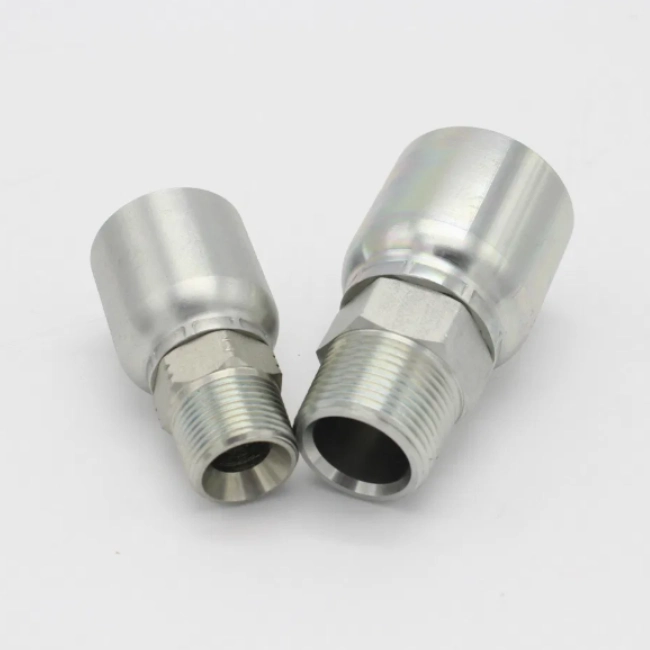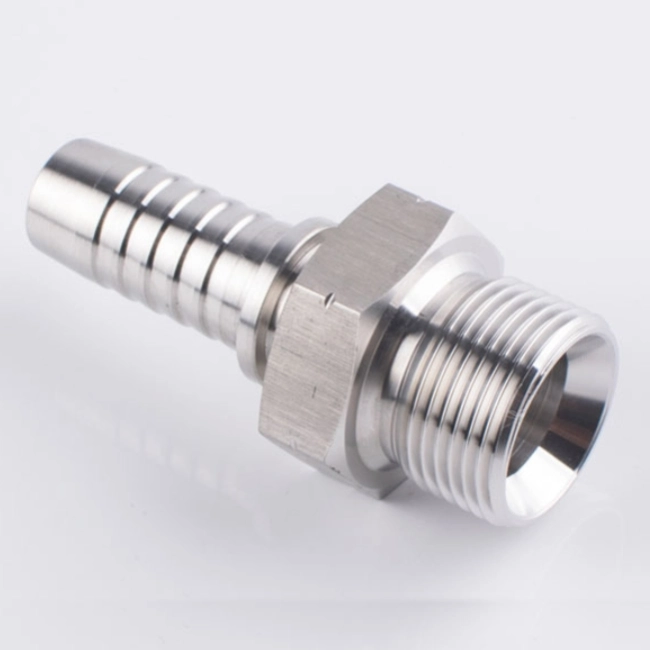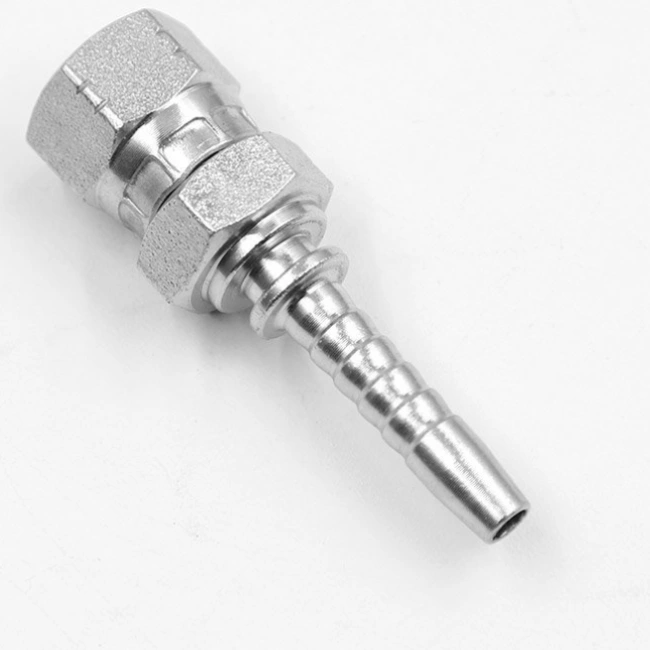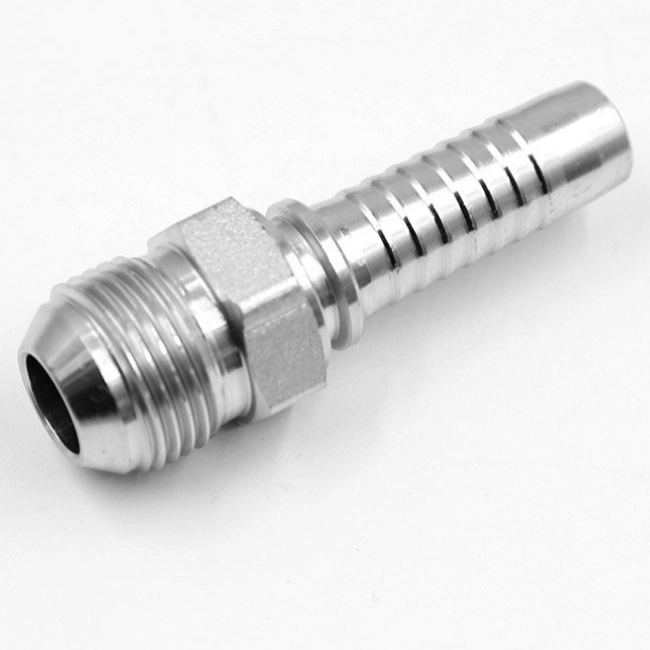JIC fittings vs NPT fittings vs BSPP fittings vs ORFS fittings, choosing the right hydraulic fittings is critical to system reliability, especially in The selection of the correct hydraulic fittings is critical to system reliability, especially in high pressure applications. The following article introduces the differences between JIC, NPT, BSPP and ORFS fittings, and provides recommendations for selecting the right fittings for high pressure hydraulic systems:
JIC vs NPT vs BSPP vs ORFS Core Difference Analysis
JIC fittings (Joint Industry Council – 37° Flare)
Sealing method: Metal-to-metal taper. Male fittings have a 37° male taper and female fittings have a 37° female taper (seating surface). When tightened, the two tapers press together to form a sealing line.
Thread: Straight (UN/UNF). Threads do not provide a seal per se, but are used only to connect and provide compression.
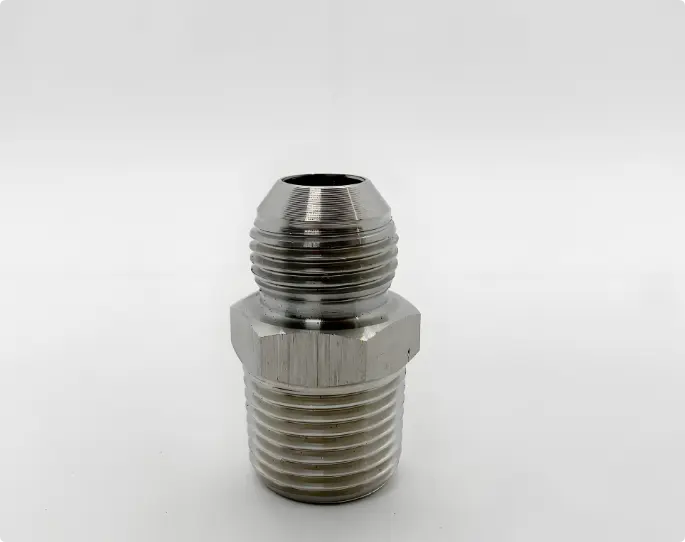
JIC fittings advantages:
Reliable sealing (when correctly installed and not subjected to shock), suitable for medium and high pressures.
Reusable (when taper is not damaged).
Very common in North America, good interchangeability.
Relatively good vibration resistance (better than NPT and BSPP).
JIC fittings disadvantages:
Sensitive to over- or under-tightening: over-tightening can cause deformation or cracking of the taper, under-tightening can leak.
Susceptibility of the taper surface to scratches or contamination affects sealing.
Under extreme high pressures or strong pulsations/vibrations, small displacements of the sealing line may occur leading to leakage (microseepage).
Installation requires precise torque.
Applications: Widely used in hydraulic, fuel, and lubrication systems in North American industry, mobile machinery (construction, agricultural), and aerospace.
NPT fittings (National Pipe Taper)
Sealing method: Conical interference sealing of the thread itself. Both male and female fittings have tapered threads (1:16 taper). When tightened, the threads are deformed to seal.
Thread: Tapered thread.
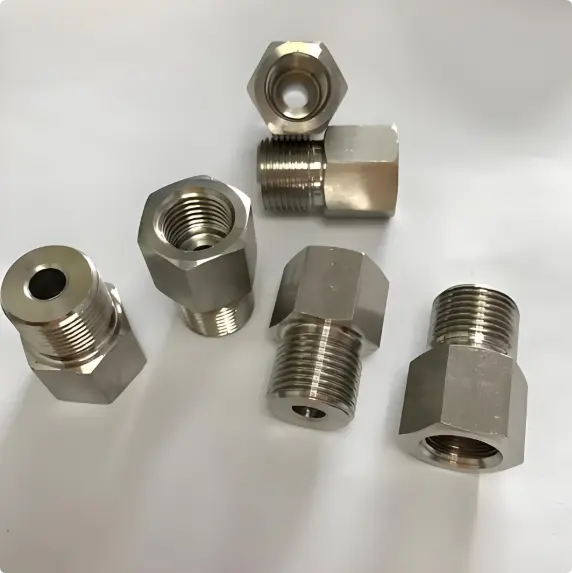
NPT fittings Advantages:
Simple construction and low cost.
Widely used in low pressure applications (e.g. pneumatic, water pipes).
NPT fittings Disadvantages:
Poor and unreliable sealing: relies on thread deformation and is prone to leakage, especially when subjected to vibration, thermal cycling or pressure fluctuations.
Sealants must be used: raw tape must be wound or sealant (anaerobic) applied, increasing the risk of contaminating the system (tape fragments, adhesive entering the system) and requiring re-treatment after disassembly.
High risk of over-tightening: Easy to over-tighten resulting in cracked fittings or ports.
Poor reusability: Sealing effectiveness decreases with each disassembly.
Poor vibration resistance: Very susceptible to loosening and leakage due to vibration.
Areas of application: Low-pressure liquid and gas piping (water, gas, low-pressure oil), strongly discouraged for medium and high-pressure hydraulic systems.
BSPP fittings (British Standard Pipe Parallel – G)
Sealing method: Face sealing gasket. Male fittings are straight thread + 30° tapered seating face (or flat face with O-ring groove), female fittings are straight thread + flat face (or with taper/flat face). The most common form of BSPP is a male taper extruding a non-metallic washer (usually a fiber or nylon composite washer) on the flat face of the female to form a seal. It is also available in the form of a metal washer (BSPP with Dowty Seal) or an O-ring.
Thread: Straight thread (Whitworth thread, tooth angle 55°).
BSPP fittings Advantages:
Good initial sealing of the gasket seal.
Installation torque requirements are relatively relaxed.
Very common in Europe and Asia (except Japan).
BSPP fittings Disadvantages:
Gaskets are prone to failure: Non-metallic gaskets are not resistant to high temperatures, pressures and certain media, and are susceptible to deterioration, extrusion and crushing. Metal washers require high surface flatness.
Limited pressure resistance: limited by the gasket material, usually used for low and medium pressure.
General vibration resistance: Gaskets can be loosened or damaged by continuous vibration.
Reusability: Gaskets often need to be replaced (especially non-metallic gaskets).
Areas of application: Industrial equipment, general machinery, low to medium pressure hydraulic systems, water and gas systems in Europe and Asia.
ORFS fittings (O-Ring Face Seal)
Sealing method: Flat extruded O-ring seal. Male fittings have a straight thread + flat end surface + O-ring groove (fitted with an O-ring), while female fittings have a straight thread + smooth, flat sealing face. When tightening, the flat surface of the male connector presses against the flat surface of the female connector, squeezing the O-ring between the groove and the flat surface of the female end to form a seal.
Thread: Straight thread (UN/UNF or Metric).
Advantages of ORFS fittings:
Excellent sealing: O-ring elastomer seals, compensates for small irregularities and deformations, is insensitive to vibrations, pulsations, pressure fluctuations and has a very low leakage rate.
High Pressure Resistance: Designed to be ideal for high pressure applications (typically nominal working pressures above JIC).
Best Vibration Resistance: Best of all types, virtually immune to loosening and leakage due to vibration.
No metal contact sealing: sealing surfaces are not easily scratched and are well protected.
Reusable: O-rings can be reused if they are not damaged (inspection or replacement is recommended).
Relatively easy to install: the specified torque can be reached without special skills (unlike JIC, which requires precise control of the taper contact).
Disadvantages of ORFS fittings:
Highest Cost: The fitting itself and the O-ring are relatively expensive.
Clean installation required: O-ring grooves and sealing surfaces need to be kept clean to prevent foreign objects from damaging the O-ring or affecting the seal.
Slightly larger size: The external dimensions are usually larger than those of a JIC fitting of the same through diameter.
Applicable fields: For sealing, pressure resistance, vibration resistance is very demanding occasions: high-pressure hydraulic systems (especially construction machinery, injection molding machines, presses), refrigeration systems, chemical processes, frequent starting and stopping or severe pulse system.
Related Article Recommendations:
Comprehensive Analysis of BSP and NPT Thread Differences and Compatibility
Comparative analysis table of four common hydraulic fitting standards, JIC, NPT, BSPP, and ORFS, including key points of difference:
| Characteristics | JIC | NPT | BSPP | ORFS |
| Full Name | Joint Industry Council | National Pipe Taper | British Standard Pipe Parallel | O-Ring Face Seal |
| Sealing Principle | Metal Tapered Seals (37° Tapered) | Thread Interference Seals (Tapered Threads) | Gaskets/End Seals (Parallel Threads) | O-Ring Flat Seals (Flat Flanges) |
| Thread Type | Straight Thread (UN/UNF) | Tapered Thread (NPT) | Parallel Thread (G Series) | Straight Thread (UN/UNF) |
| Thread Standards | SAE J514 (AFSL) | ANSI B1.20.1 (AFSL) | ISO 228/EN 10226 (BS) | SAE J1453 (AFSL) |
| Seal Required | No | Thread Sealant/Raw Tape Required | Flat Washer (Copper/Nylon) Required | O-Ring (Rubber/Fluoroelastomer) Required |
| Pressure Rating | Medium High Pressure (≤5000 PSI) | Medium Pressure (≤3000 PSI) | Medium Pressure (≤3000 PSI) | Ultra High Pressure (≤6000 PSI) |
| Vibration Resistance | Good | Fair (prone to loose leakage) | Good (gasket compensation) | Excellent (O-ring elasticity) |
| Installation Torque Requirements | Precise (over-tightening damages taper) | Experience Dependent (sealant amount sensitive) | Medium (gasket compression control) | Precise (uniform O-ring compression) |
| Common Applications | Construction Machinery, Agricultural Equipment | North America General Purpose Low Pressure Piping | Europe Hydraulics, Pneumatics | High Vibration/High Pressure Scenarios (Aerospace, Marine) |
| Interchangeability | Incompatible with BSPT | Incompatible with BSPP/BSPT | Incompatible with NPT/JIC | Specialized design (matching connector required) |
Related Article Recommendations:
The Ultimate Guide to BSPT Threads and BSPP Threads
JIC fittings vs NPT fittings vs BSPP fittings vs ORFS fittings, how to choose high pressure hydraulic system?
For high-pressure hydraulic systems (often referred to as systems with working pressures above 250 bar or where there are severe vibrations, pressure shocks/pulses), ORFS is often the preferred and most reliable choice.
Why are ORFS fittings best suited for high pressures?
Superior sealing: The elastic O-ring seal adapts effectively to pressure fluctuations and vibrations, virtually eliminating micro-seepage (which can occur in JIC high-pressure systems).
Resistance to vibration/pulsation: The sealing mechanism is insensitive to dynamic loads and performs particularly well on equipment such as excavators and breakers.
High Pressure Resistance: The design pressure rating is typically higher than that of a similarly sized JIC fitting.
High reliability: When correctly installed, leakage failure rates are much lower than JIC, NPT and BSPP.
JIC fittings in high-pressure systems
JIC fittings are widely used in high-pressure systems (especially in North America) and generally perform acceptably.
However, the risk of microseepage or loosening of the JIC is much higher than that of the ORFS under extreme high pressures, severe vibration, or high-frequency pressure pulses.
Where system pressures are high but operating conditions are relatively smooth (e.g., stationary hydraulic stations) and budget constraints or the North American supply chain predominates, JICs are still a common choice, subject to tight control of installation quality (torque, taper protection).
The role of NPT and BSPP in high pressure systems:
NPT: Definitely not suitable for high pressure hydraulic systems. Its sealing principle is unreliable, relies on raw tape/sealant (risk of contamination) and is highly prone to leakage under vibration. It should be avoided in specialized hydraulics.
BSPP (with non-metallic gasket): Not recommended for high pressure systems. The gasket material limits its pressure and temperature resistance and is prone to extrusion or failure under high pressure. Although metallic gasket forms are available, they do not perform as well or are as popular as ORFS.
JIC Fittings vs NPT Fittings vs BSPP Fittings vs ORFS Fittings Summary and Selection Recommendations
- Preferred (highest performance/reliability): ORFS – If you are looking for the highest level of seal integrity, high pressure, vibration and impulse resistance, and your budget allows it, ORFS is the best choice for high pressure hydraulic systems. Highly recommended for new systems or retrofit projects where reliability is critical.
- Common/Acceptable (Mainstream in North America, with attention to operating conditions): JIC – One of the standard choices for high pressure systems in North America and widely used. Performs well in high pressure systems with smooth conditions (no severe vibration/pulsation). Be sure to install accurately and protect the cone sealing surface. If vibration is a problem in the system, the JIC may not be the optimal solution. 3.
- Avoid use:
NPT: Should be avoided in any serious hydraulic system, especially high pressure systems.
BSPP (with non-metallic gasket): Not suitable for high pressure systems. Even in the form of a metal washer, there is no performance advantage over ORFS.
JIC fittings vs. NPT fittings vs. BSPP fittings vs. ORFS fittings is a final decision to be made:
Specific Operating Pressure: The higher the pressure, the greater the advantage of ORFS.
System Dynamics: The more severe the vibration, shock, and pressure pulses, the more necessary the ORFS.
Geographic location and supply chain: JICs are more popular in North America and BSPPs are more common in Europe/Asia, but ORFS is being promoted as a high-performance option in specialized areas around the world.
Cost Budget: ORFS has a higher initial cost, but its high reliability and low maintenance costs (reduced leak downtime, cleaning costs) often offset the initial investment in critical applications.
Industry Standards and Codes: Does your industry or customer have specific requirements?
Existing System Compatibility: Is this a new system or a retrofit of an existing system?
Conclusion:
For optimum performance, reliability and leak-free operation in high-pressure hydraulic systems, especially in the presence of vibration or pulsation, ORFS fittings are the best technical choice. jic is a common high-pressure solution in the north american market, but is not as reliable as orfs under extreme conditions. npt and bspp with non-metallic gaskets should be avoided in high-pressure hydraulic systems.
It is recommended that you make your final selection based on the specific pressure rating of your system, dynamic operating conditions, budget, and reliability requirements. If conditions permit, ORFS will save you a lot of trouble in post maintenance.

